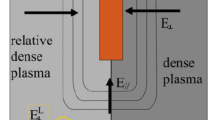Abstract
FROM time to time theories of the aurora have been proposed which invoke locally developed electric fields as the mechanism causing acceleration of solar particles into the relatively low levels of the ionosphere at which visible aurora usually occurs. However, these theories have been concerned mainly with an explanation of the classical idealized magnetic storm, treating the auroral phenomena as a by-product, and not attempting any detailed explanation of auroral morphology. One notable exception is the recent work of Chamberlain1, in which an attempt has been made to explain the luminosity-height characteristics of an auroral ray in terms of an electric field in the ionosphere. The purpose of this communication is to present a crude qualitative description of the development of a typical auroral display as a result of the growth of an electric field in the ionosphere.
Similar content being viewed by others
References
Chamberlain, J. W., “The Airglow and the Auroræ” (Pergamon Press, 1955).
Chapman, S., and Cowling, T. G., “The Mathematical Theory of Non-Uniform Gases” (Cambridge Univ. Press, 1952).
Martyn, D. F., Nature, 167, 92 (1951).
Winckler, J. R., Peterson, L., Arnoldy, R., and Hoffman, R., Phys. Rev., 110, 1221 (1958).
Author information
Authors and Affiliations
Rights and permissions
About this article
Cite this article
REID, G. Electric Field Theory of Auroræ. Nature 182, 1791–1792 (1958). https://doi.org/10.1038/1821791a0
Issue Date:
DOI: https://doi.org/10.1038/1821791a0
- Springer Nature Limited





